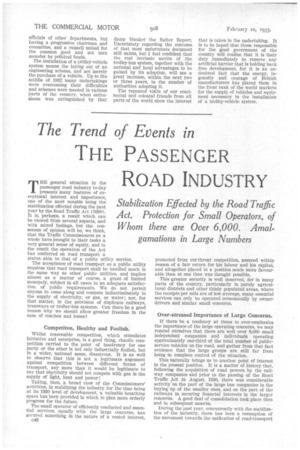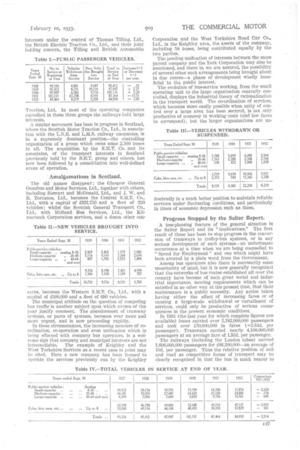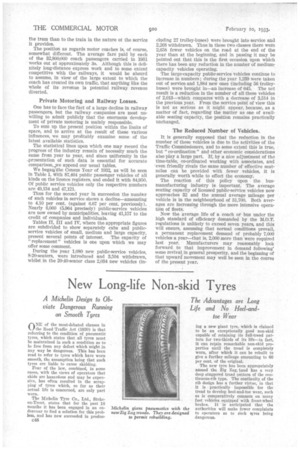The Trend of Events in
Page 96

Page 97

Page 98

If you've noticed an error in this article please click here to report it so we can fix it.
THE PASSENGER ROAD INDUSTRY
THE _general situation in the passenger road industry to-day presents many features of exceptional interest and importance, one of the most notable being the stabilization effected during the past year by the Road Traffic Act (1930). It is, perhaps, a result which can be viewed from several aspects, and with mixed feelings, but the consensus of opinion will be, we think, that the Traffic Commissioners as a whole have brought to their tasks a very general sense of equity, and in the result the operation of the Act has conferred on road transport a
status akin to that of a public utility service. .
The acceptance of road transport as a public utility requires that road transport shall be handled much in the same way as other public utilities, and implies almost as a matter of course, a grant of limited monopoly, subject in all eases to an adequate satisfaction of public requirements. We do not permit anyone to come along and compete indiscriminately in the supply of electricity, or gas, or water ; nor, for that matter, in the provision of duplicate railways, tramways or trolley-bus systems. Can there be a good reason why we should allow greater freedom in the case of coaches and buses?
Competiton, Healthy and Foolish.
Whilst reasonable competition, which stimulates Initiative and enterprise, is a good thing, chaotic competition carried to the point of insolvency for one party or the other is not only industrially foolish, but in a wider, national sense, disastrous. It is as well to observe that this is not a legitimate argument against competition between different forms of transport, any more than it would be legitimate to say that electricity should not compete with gas in the supply of light, heat and power !
Taking, then, a broad view of the Commissioners' activities, in stabilizing the industry for the time being at its 1930 level of development, a valuable breathing space has been provided in which to plan more orderly progress for the future.
The small operator of efficiently conducted and essential services, equally with the large concerns, has secured something in the nature of a vested interest,
c46
protected from cut-throat competition, assured within reason of a fair return for his labour and his capital, and altogether placed in a position much more favourable than at one time was thought possible.
This greater security is well deserved, for in many parts of the country, particularly in purely agricultural districts and other thinly populated areas, where the receipts per mile are of low average, many essential services can only be operated economically by ownerdrivers and similar small concerns.
Over-stressed Importance of Large Concerns.
If there be a tendency at times to over-emphasize the importance of the large operating concerns, we may remind ourselves that there are well over 6,000 small independent companies and individuals operating approximately one-third of the total number of publicservice vehicles on the road, and gather from that fact evidence that the large groups are still far from being in complete control of the situation.
This naturally brings us to another point of interest in the present position. It is a matter of history that, following the acquisition of road powers by the railway companies and prior to the passing of the Road Traffic Act -in August, 1930, there was considerable activity on the part of the large bus companies in the buying up of the smaller one, and on the part of the railways in securing financial interests in the larger concerns. A good deal of consolidation took place then and in subsequent months.
During the past year, concurrently with the stabilization of the industry, there has been a resumption of the movement towards the unification of road-transport interests under the control of Thomas Tilling, Ltd.,. the British Electric Traction Co., Ltd., and their joint holding concern, the Tilling and British Automobile Traction, Ltd. In most of the operating companies embodied in these three groups the railways hold large interests.
A similar movement has been in progress in Scotland, where the Scottish Motor Traction Co., Ltd., in association with the L.N.E. and L.M.S. railway companies, is in a supremely dominant position-the controlling organization of a group which owns some 2,500 buses in all. The acquisition by the S.M.T. Co. and its associates, of the transport interests in Scotland previously held by the B.E.T. group and others, has now been followed by a consolidation into well-defined areas of operation.
' Amalgamations in Scotland.
The old names disappear; the Glasgow General Omnibus and Motor Services, Ltd., together with others, including Stewart and McDonald, Ltd.. and J. W. and R. Torrance, Ltd., becomes the Central S.M.T. Co., Ltd., with a capital of £332,750 and a fleet of 320 vehicles ; whilst the Scottish General Transport Co., Ltd., with Midland Bus Services, Ltd., the Kilmarnock Corporation services, and a dozen other con cerns, becomes the Western Co., Ltd., with a capital of £500,000 and a fleet of 690 vehicles.
The municipal attitude on the question of competing bus traffic is another subject upon which events of the year justify comment. The abandonment of tramway systems, or parts of systems, becomes ever more and more urgent, and is now proceeding rapidly.
In these circumstances, the increasing measure of coordination, co-operation and even unification which is being effected with company bus operators, is a welcome sign that company and municipal interests are not irreconcilable. The example of Keighley and the West Yorkshire Services as a recent case in point may he cited. here a new company has been formed to operate the services previously run by the Keighley Corporation and the West Yorkshire Road Car Co., Ltd., in the Keighley area, the assets of the company, including 58 buses, being contributed equally by the two parties. The pending unification of interests between the same parent company and the York Corporation may also be mentioned, and there is, we are assured, the possibility of several other such arrangements being brought about in due course-a phase of development wholly beneficial to the public interest.
The evolution of bus-service working, from the small operating unit to the large organization centrally controlled, displays the industrial theory of rationalization in the transport world. The co-ordination of services, which becomes more easily possible when. unity of control over a large area has been secured, is not only productive of economy in working costs (and low fares to correspond), but the larger organizations are un
Progress Stopped by the Salter Report.
'A less-pleasing feature of the general situation is the Salter Report and its "implications." The first result of these has been to stop progress in the conversion of tramways to trolley-bus systems, or in any serious development of such systems-an unfortunate occurrence at a time when we are being counselled to "Spend for Employment" and one which might have been averted by a plain word from the Government.
Among bus operators also there is necessarily some 'uncertainty of mind, but it is now generally recognized that the networks of bus routes established all over the country have become of such great social and industrial importance, meeting requirements which can be satisfied in no other way at the present time, that their maintenance is a public necessity. Any action taken having either the effect of increasing fares or of causing a large-scale withdrawal or curtailment of services, could only be productive of serious consequences in the present economic conditions.
In 1931 (the last year for which complete figures are available) buses carried over 5,182,000,000 passengers and took over 150,600,000 in fares ( -2.34d. per passenger). Tramways carried nearly 4,108,000,000 passengers at an average fare of 1.35d. per passenger.
The railways (including the London tubes) carried 1,606,000,000 passengers for 06,200,000-an average of 10d. per passenger. Thus the relative position of rail and road as competitive forms of transport may be clearly recognized in that the bus is much nearer to the tram than to the train in the nature of the service it provides.
The position as regards motor coaches is, of course, somewhat different. The average fare paid by each of the 32,800000 coach passengers carried in 1931 works out at approximately 3s. Although this is definitely long-distance express work and to some extent competitive with the railways, it would be absurd to assume, in view of the large extent to which the coach has created its own traffic, that anything like the whole of its revenue is potential railway revenue diverted.
Private Motoring and Railway Losses.
One has to face the fact of a large decline in railway passengers, but the railway companies are most unwilling to admit publicly that the enormous development of private motoring is mainly responsible.
To sum up the present position within the limits of space, and to arrive at the result of these various influences, we may profitably examine some of the latest available statistics.
The statistical lines upon which one may record the progress of the industry remain of necessity much the same from year to year, and since uniformity in the -presentation of such data is essential for accurate comparison, „we append our usual tables. We began/the Census Year of 1932, as will be seen In Table I, With 87,464 public passenger vehicles of all kinds on the licence registers, and ended it with 84,950. Of public service vehicles only the respective numbers are 49,134 and 47,121.
Thus for the second year in succession the numlrer of such vehicles in service shows a decline—amounting to 4.10 per cent. (against 6.67 per cent. previously). Nearly 6,000 (5,964 precisely) public-service vehicles are now owned by municipalities, leaving 41,157 to the credit of companies and individuals.
Tables II, HI and IV, where the appropriate figures are subdivided to show separately cabs and publicservice vehicles of small, medium and large capacity, present several points of interest. The capacity of " replacement " vehicles is one upon which we may offer some comment.
During the year 1,080 new public-service vehicles, 8-20-seaters, were introduced and 3,504 withdrawn, whilst in the 20-40-seater class 2,034 new vehicles (in eluding 27 trolley-buses) were brought into service and 2,268 withdrawn. Thus in these two classes there were 2,658 fewer vehicles an the road at the end of the year than at the beginning, and in passing it may be pointed out that this is the first occasion upon which there has been any reduction in the number of mediumcapacity vehicles operating.
The large-capacity public-service vehicles continue to increase in numbers ; during the year 1,239 were taken out of service and 1,884 new ones (including 56 trolleybuses) were brought in—an increase of 645. The net result is a reduction in the number of all these vehicles of 2,013—which compares with a decrease of 3,514 in the previous year. From the service point of view this is not as serious as it might appear, because, as a matter of fact, regarding the matter as one of available seating capacity, the position remains practically unchanged.
The Reduced Number of Vehicles.
It is generally supposed that the reduction in the number of these vehicles is due to the activities of the Traffic Commissioners, and to some extent this is true, but " co-ordination" and other economic considerations also play a large part. If, by a nice adjustment of the time-table, co-ordinated working with associates, and -even friendly rivals the same number of effective seatmiles can be provided with fewer vehicles, it is generally worth while to effect the economy.
The reaction of this policy upon the busmanufacturing industry is important. The average seating capacity of licensed public-service vehicles now approaches 32 and the annual average mileage per vehicle is in the neighbourhood of 31,700. Both averages are increasing through the more intensive operatiOn of fleets.
Now the average life of a coach or bus under the high standard of efficiency demanded by the M.O.T. regulations is unlikely to exceed seven years, and this will ensure, assuming that normal conditions prevail, a permanent replacement demand of probably 7,000 vehicles a year—that is, 2,000 more than were required last year. Manufacturers may reasonably look forward to that improvement in demand following' some revival in general prosperity, and the beginning of that upward movement may well be seen in the course of the present year.




































































































































































